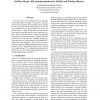Free Online Productivity Tools
i2Speak
i2Symbol
i2OCR
iTex2Img
iWeb2Print
iWeb2Shot
i2Type
iPdf2Split
iPdf2Merge
i2Bopomofo
i2Arabic
i2Style
i2Image
i2PDF
iLatex2Rtf
Sci2ools
USENIX
2003
2003
In-Place Rsync: File Synchronization for Mobile and Wireless Devices
The open-source rsync utility reduces the time and bandwidth required to update a file across a network. Rsync uses an interactive protocol that detects changes in a file and sends only the changed data [18,19]. We have modified rsync so that it operates on space constrained devices. Files on the target host are updated in the same storage the current version of the file occupies. Space-constrained devices cannot use traditional rsync because it requires memory or storage for both the old and new version of the file. Examples include synchronizing files on cellular phones and handheld PCs, which have small memories. The in-place rsync algorithm encodes the compressed representation of a file in a graph, which is then topologically sorted to achieve the in-place property. We compare the performance of in-place rsync to rsync and conclude that in-place rsync degrades performance minimally.
| Added | 01 Nov 2010 |
| Updated | 01 Nov 2010 |
| Type | Conference |
| Year | 2003 |
| Where | USENIX |
| Authors | David Rasch, Randal C. Burns |
Comments (0)

